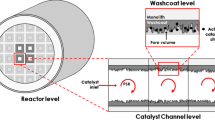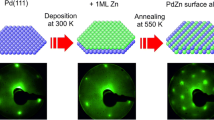Abstract
A short review of the works where theoretical models for describing kinetics of catalytic X–H bonds breaking reactions (X = C, O, and H) over metal surfaces were developed on the basis of concepts of the Dogonadze–Kuznetsov–Levich quantum mechanical theory of chemical processes. Numerical values of the rate constants of these reactions over (111) surfaces of nickel, platinum and rhodium, which are considered as steps of a complex catalytic process of methane steam reforming (MSR) are calculated and compared with experimental data. These rate constants are used for simulations of microkinetic models of the MSR reactions on the catalysts. Effects of external parameters on the MSR rates and on isotope effects are described.
Similar content being viewed by others
References
Levich, V.G. and Dogonadze, R.R., Theory of nonradiative electronic transitions between Ions in Solution, Dokl. Akad. Nauk SSSR, vol. 124, p. 123.
Levich, V.G. and Dogonadze, R.R., The adiabatic theory of electron processes in solutions, Dokl. Akad. Nauk SSSR, 1960, vol. 133, p. 158.
Levich, V.G. and Dogonadze, R.R., Adiabatic theory of electron transfer processes in solution, Coll. Czech. Chem. Comm., 1961, vol. 26, p. 193.
Levich, V.G., Present state of the theory of oxidationreduction in solution (bulk and electrode reactions), Adv. Electrochem. Electrochem. Eng., 1966, vol. 4, p. 249.
Levich, V.G., Dogonadze, R.R., and Kuznetsov, A.M., Theory of hydrogen-ion discharge on metals: Case of high overvoltages, Electrochim. Acta, 1968, vol. 13, p. 1025.
Dogonadze, R.R. and Kuznetsov, A.M., Theory of charge transfer kinetics at solid-polar liquid interfaces, Progr. Surf. Sci., 1975, vol. 6, p. 1.
Dogonadze, R.R. and Kuznetsov, A.M., Quantum Electrochemical Kinetics: Continuum Theory, Comprehensive Treatise of Electrochemistry, Vol. 7, New York: Plenum Publishing Corp., 1983, p. 40.
Kuznetsov, A.M., Charge Transfer in Physics, Chemistry and Biology, Reading, UK: Gordon & Breach, 1995, p. 622.
Kuznetsov, A.M., Stochastic and Dynamic Views of Chemical Reaction Kinetics in Solutions, Lausanne, Switzerland: Press polytechniques et universitaires romandes, 1999, p. 260.
Kuznetsov, A.M. and Ulstrup, J., Electron Transfer in Chemistry and Biology, New York: John Wiley & Sons, 1999, p. 350.
German, E.D. and Sheintuch, M., Predicting CH4 dissociation kinetics on metals: trends, sticking coefficients, H tunneling and kinetic isotope effect, J. Phys. Chem. C, 2013, vol. 117, p. 22811.
German, E.D., Nekhamkina, O., Temkin, O.N., and Sheintuch M., H-tunneling effects on sequential dissociation of methane over Ni(111) and the overall rate of methane reforming, J. Phys. Chem. C, 2015, vol. 119, p. 9260.
German, E.D. and Sheintuch, M., Methane steam reforming rates over Pt, Rh and Ni(111) accounting for H tunneling and for metal lattice vibrations, Surf. Sci., 2016, vol. 656, p. 126.
Lee, M.B., Yang, Q.Y., and Ceyer, S.T., Dynamics of the activated chemisorption of CH4 and implication for the pressure gap in catalysis: A molecular beam-high resolution electron energy loss study, J. Chem. Phys., 1987, vol. 87, p. 2724.
German, E.D., Kuznetsov, A.M., and Sheintuch, M., Predicting the activation energy of catalytic dissociation of the hetero-atomic AB bond, Chem. Phys., 2006, vol. 324, p. 129.
Landau, L.D. and Lifshitz, E.M., Quantum Mechanics, N.Y.: Pergamon Press, 1991, p. 677.
Merzbacher, E., Quantum Mechanics, 2nd ed., N.Y.: Wiley, 1970, p. 621.
German, E.D. and Sheintuch, M., Kinetics of catalytic OH dissociation on metal surfaces, J. Phys. Chem. C, vol. 116, p. 5700.
Georgievskii, Y. and Stuchebrukhov, A.A., Concerted electron and proton transfer: Transition from non-adiabatic to adiabatic proton tunneling, J. Chem. Phys., 2000, vol. 113, p. 10438.
Lee, M.B., Yang, Q.Y., and Ceyer, S.T., Dynamics of the activated chemisorption of CH4 and implication for the pressure gap in catalysis: A molecular beam-high resolution electron energy loss study, J. Chem. Phys., 1987, vol. 87, p. 2724.
Jachimowski, T.A., Hagedorn, C.J., and Weinberg, W.H., Direct and trapping-mediated dissociative chemisorption of methane on Ir(111), Surf. Sci., 1997, vol. 393, p. 126.
Mortensen, H., Diekhner, L., Baurichter, A., and Luntz, A.C., J. Chem. Phys., 2002, vol. 116, p. 5781.
Luntz, A.C. and Bethune, D.S., Activation of methane dissociation on a Pt(111) surface, J. Chem. Phys., 1989, vol. 90, p. 1274.
Wei, J. and Iglesia, E., Pathways and site requirements for the activation and chemical conversion of methane on Ru-based catalysts, J. Phys. Chem. B, 2004, vol. 108, p. 4094.
Beebe, T.P., Jr., Goodman, D.W., Kay, B.D., and Yates, J.T., Jr., Kinetics of the activated dissociative adsorption of methane on the low index planes of nickel single crystal surfaces, J. Chem. Phys., 1987, vol. 87, p. 2305.
Jiang, X. and Goodman, D.W., Dissociative adsorption of alkanes on clean and sulfur-modified nickel surfaces, Appl. Phys. A, 1990, vol. 51, p. 99.
Burghgraef, H., Jansen, A.P.J., and van Santen, R.A., Electronic structure calculations and dynamics of methane activation on nickel and cobalt, J. Chem. Phys., 1994, vol. 101, p. 11012.
Burghgraef, H., Jansen, A.P.J., and van Santen, R.A., Methane activation and dehydrogenation on nickel and cobalt: a computational study, Surf. Sci., 1995, vol. 324, p. 345.
Yang, H. and Whitten, J. L., Ab initio chemisorption studies of CH3 on Ni(111), J. Am. Chem. Soc., 1991, vol. 113, p. 6442.
Abid-Pedersen, F., Lytken, O., Engbaek, J., Nielsen, G., Chorkendorff, I., and Nørskov, J.,K., Methane activation on Ni(111): Effects of poisons and step defects, Surf. Sci., 2005, vol. 590, p. 127.
Bengaard, H.S., Alstrup, I., Chorkendorf, I., Ullmann, S., Rostrup-Nielsen, J.R., and Nørskov, J.K., Chemisorption of methane on Ni(100) and Ni(111) surfaces with preadsorbed potassium, J. Catal., 1999, vol. 187, p. 238.
Bukoski, A., Abbott, H.L., and Harrison, I., Microcanonical unimolecular rate theory at surfaces, III: Thermal dissociative chemisorption of methane on Pt(111) and detailed balance, J. Chem. Phys., 2005, vol. 123, p. 094707.
Abbott, H.L. and Harrison, I., Methane dissociative chemisorption on Ru(0001) and comparison to metal nanocatalysts, J. Catal., 2008, vol. 254, p. 27.
Abbott, H.L. and Harrison, I., Dissociative chemisorption and energy transfer for methane on Ir(111), J. Phys. Chem. B, 2005, vol. 109, p. 10371.
Marsh, A.L., Becraft, K.A., and Somorjai, G.A., Methane dissociative adsorption on the Pt(111) surface over the 300–500 K temperature and 1–10 Torr pressure ranges, J. Phys. Chem. B, 2005, vol. 109, p. 13619.
DeWitt, K.M., Valadez, L., Abbott, H.L., Kolasinski, K.W., and Harrison, I.J., Using effusive molecular beams and microcanonical unimolecular rate theory to characterize CH4 dissociation on Pt(111), J. Phys. Chem. B, 2006, vol. 110, p. 6705.
Higgins, J., Conjusteau, A., Scoles, G., and Bernasek, S.L., State vibrational (2v3) activation of the chemisorption of methane on Pt(111), J. Chem. Phys., 2001, vol. 114, p. 5277.
Zeigarnik, A.V. and Shustorovich, E., The UBI-QEP method: Mechanistic and kinetic studies of heterogeneous catalytic reactions, Russ. J. Phys. Chem. B, 2007, vol. 1, p. 330.
Larsen, J.H., Holmblad, P.M., and Chorkendorff, I., Dissociative sticking of CH4 on Ru(0001), J. Chem. Phys., 1999, vol. 110, p. 2637.
Winters, H.F., The kinetic isotope effect in the dissociative chemisorption of methane, J. Chem. Phys., 1976, vol. 64, p. 3495.
Bell, R.P., The Proton in Chemistry, 2nd ed., London: Chapman and Hall, 1973, p. 310.
Jones, G., Jakobsen, J.G., Shim, S.S., Kleis, J., Andersson, M.P., Rossmeisl, J., Abid-Pedersen, F., Bligaard, T., Helveg, S., Hinneman, B., Rostrup-Nielsen, J.R., Chorkendorff, I., Sehested, J., and Norskov, J.K., First principles calculations and experimental insight into methane steam reforming over transition metal catalysis, J. Catal., 2008, vol. 259, p. 147.
Sprung, C., Arstad, B., and Olsbye, U., Methane steam reforming over a Ni/NiAl2O4 model catalyst–kinetics, Chem. Cat. Chem., 2014, vol. 6, p. 1969.
Wei, J. and Iglesia, E., Isotopic and kinetic assessment of the mechanism of reactions of CH4 with CO2 or H2O to form synthesis gas and carbon on nickel catalysts, J. Catal., 2004, vol. 224, p. 370.
Author information
Authors and Affiliations
Corresponding author
Additional information
Published in Russian in Elektrokhimiya, 2017, Vol. 53, No. 10, pp. 1379–1389.
This paper is the authors’ contribution to the special issue of Russian Journal of Electrochemistry dedicated to the 100th anniversary of the birth of the outstanding Soviet electrochemist Veniamin G. Levich.
The article is published in the original.
Rights and permissions
About this article
Cite this article
German, E.D. Theoretical models of X–H bonds breaking (X = C, O, and H) over metal surfaces: Used for simulation of catalytic methane steam reforming. Russ J Electrochem 53, 1222–1231 (2017). https://doi.org/10.1134/S1023193517100044
Received:
Accepted:
Published:
Issue Date:
DOI: https://doi.org/10.1134/S1023193517100044




